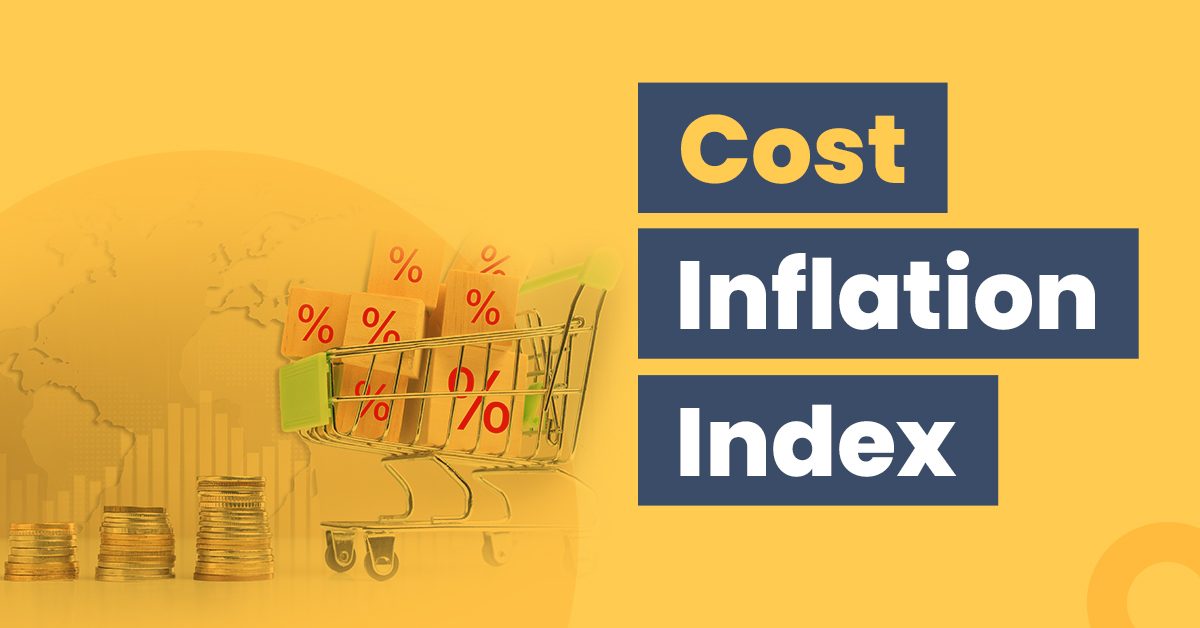Cost Inflation Index (CII) – Overview, Calculation Table and Example


The economy is always subject to changes, with inflation usually rising every year. As a result, the price of goods and services keeps increasing, which lowers people’s purchasing power. The cost inflation index (CII) lets you estimate the general rise in prices in the economy.
This article discusses how CII works and how you can use it to your benefit.
What Is the Cost Inflation Index?
The cost inflation index (CII) is a tool to observe the rise in prices of goods and services over time. The Central Government sets the Cost Inflation Index every year .
Knowing the CII of a year allows you to match the prices of a product/asset to the economy’s inflation rate. You can find the CII in the official gazette published by GOI. This index receives updates every year as per Section 48 of the Income Tax Act.
For some assets, such as debt funds, property or jewellery, investors are allowed to adjust their purchase prices using CII. This lets them reduce their overall tax liability as per the inflation rate. This indexation benefit is applicable only for long-term capital gains.
CII amounts to 75% of the average increase in the consumer price index or CPI of last year. CPI compares the current price of a basket of goods and services with the previous year to calculate the increase in prices.
Why Is the Cost Inflation Index Important?
Prices of goods and services increase every year due to inflation. This means that most goods and services become more expensive for people over time, which reduces their purchasing power.
Let us say that the average price of kerosene is Rs. 70/litre for a particular year. After a few years, it becomes Rs. 140 per litre, making it doubly expensive for the ordinary person. However, it can be difficult to measure changes in the prices of every product and service. Cost inflation index measures this change.
The government allows people to calculate the inflation-adjusted price of certain assets. When people sell such assets and accrue long-term capital gains, they can use this CII number to adjust their tax liability accordingly.
Also Read: What are International Commodity Markets
How is the Cost Inflation Index Used?
CII plays a vital role in determining these things:
- For Long Term Capital Gains (LTCG)
The recorded value of every long-term capital asset is its cost price on purchase. This price remains the same for as long as you hold these assets despite the effects of inflation. However, the selling price of these assets will increase due to market fluctuation. This will further lead to larger capital gains and higher income tax.
For certain long-term capital assets, one can use CII to adjust their price for indexation. This will increase its purchase price and decrease the net profits. You can use this indexation facility to reduce your tax liability.
- To Verify and Monitor Price Hike
The Central Government uses CPI to understand changes in the selling price of goods against inflation rates. This helps them monitor constant price hikes of these commodities during inflation and manage the same.
New Cost Inflation Index Table
The following is the Cost Inflation Index table for calculating LTCG:
| Financial Years | Cost Inflation Index (CII) |
| 2001-2002 (Base Year) | 100 |
| 2002-2003 | 105 |
| 2003-2004 | 109 |
| 2004-2005 | 113 |
| 2005-2006 | 117 |
| 2006-2007 | 122 |
| 2007-2008 | 129 |
| 2008-2009 | 137 |
| 2009-2010 | 148 |
| 2010-2011 | 167 |
| 2011-2012 | 184 |
| 2012-2013 | 200 |
| 2013-2014 | 220 |
| 2014-2015 | 240 |
| 2015-2016 | 254 |
| 2016-2017 | 264 |
| 2017-2018 | 272 |
| 2018-2019 | 280 |
| 2019-2020 | 289 |
| 2020-2021 | 301 |
| 2021-2022 | 317 |
| 2022-2023 | 331 |
Calculation of Cost Inflation Index with Example
Let’s consider an example to understand this concept better.
Meera purchased an asset with ₹1,50,000 in May 2016. She sold the same in June 2021 for ₹2,00,000.
Let’s find out her CII, ICOA and Meera’s taxable capital gain/loss.
To begin with, we must note down the CII for the years of purchase and sale of assets. To do so, you may take help from the table above.
CII of year 2016-2017= 264
CII for year 2021-2022= 317
Now, we need to know CII on the purchase price of Meera’s assets. For this, we must use the following formula:
Cost Inflation Index = CII of the year of selling the asset/ CII of the purchasing year of the asset.
Therefore, CII on Meera‘s asset= 317/264= 1.20
Now, ICOA on her asset will be
ICOA= Purchase price of asset * (CII of the year of selling the asset/ CII of the purchasing year of the asset)
Indexed Cost of Acquisition of asset (ICOA) = 1,50,000*1.20= ₹1,80,000
Furthermore, Meera’s long-term taxable capital gain will be as follows
Taxable capital gain = Selling price of an asset – Indexed Cost of Acquisition of asset (ICOA)
= ₹(2,00,000-1,80,000)= ₹20,000
Therefore, Meera has to pay tax on the profit of ₹20,000 instead of her original profit, which is ₹50,000.
This way, CII will help individuals reduce taxation on their capital gains.
Essential Features of Cost Inflation Index
Here are some important features of the Cost Inflation Index that you must remember.
- You can calculate the indexed purchase cost of your asset to reduce your LTCG.
- With the help of CII, you can estimate any hike in asset prices owing to inflation.
- You can calculate the indexation rate by comparing base year to indexes of all years.
- The Central Government sets the base year. Therefore, CII calculation revolves around a particular calendar year.
- One must ignore the improvement costs incurred before April 2001.
Final Word
As you gain insights into the Cost Inflation Index, there is one point one needs to remember. It does not apply to equities but to certain assets like houses, land, gold jewellery, debt mutual funds (Starting 1st April 2023, indexation benefit is not available in Debt Mutual fund) etc. The CII table provided above will help you calculate your taxable capital gains and lower your income tax return burden.
Frequently Asked Questions
What is the Consumer Price Index (CPI)?
Consumer Price Index is a tool to measure the cost of a basket of goods and services that represent a country’s current economy against this same basket’s price in the previous year. This calculation helps to determine the increase in prices.
What is a base year in CII?
The government sets a particular calendar year as the starting point for CII calculation. This is known as the base year. To compute the rise in prices of products, services and commodities, the government calculates the CII by comparing ongoing year to its base year.
Are Short-Term Capital Gains eligible for benefits from indexation?
Capital gains from long-term assets are only eligible to enjoy benefits from indexation. Therefore, you cannot adjust gains from any asset if you sell them within two years of purchase.



